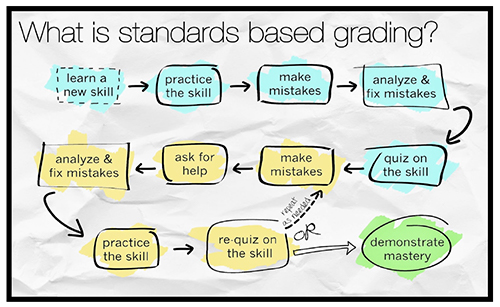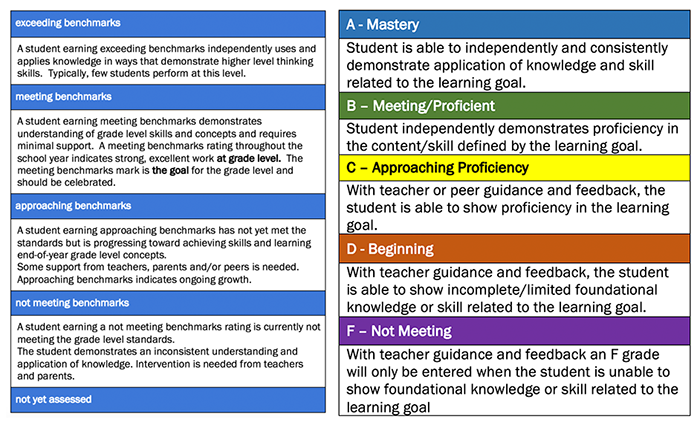Standards-Based Grading
What is Standards-based Grading?
A standards-based grading system organizes evidence of student progress and mastery according to standards associated with a subject within a course: e.g. interpreting data from maps/charts.
A traditional grading system organizes evidence of student progress and mastery by types of learning activities: e.g. classwork, homework, assignments.
Letter grades may be used in both systems, and in our standards-based online Skyward Gradebook, student progress toward mastery is reported as a letter grade.
The standards-based grading system uses grades to indicate progress toward mastery of the standards within a course, not how a student performs on quizzes in general.
P.K. Yonge Assessment, Feedback, Reporting Handout
Standards-based Grading Report Card Sample
Family Conversation | Assessment, Feedback, Reporting – 10.16.2018

Why is P.K. Yonge using a standards-based grading system?
P.K. Yonge is moving to a standards-based grading system to provide students, families, and teachers with more specific information about student progress toward mastery of content and skill standards.
The standards-based system helps target instruction, reinforcement, and enrichment opportunities for all students. It also provides students and families a clearer picture of what students should know and be able to do by the end of each grade level.
Standards-based grading helps clearly communicate progress a student is making toward meeting content and skill standards by providing indicators of progress on specific content or skills rather than on types of activities (quizzes, homework, assignments). The system is tightly focused on tracking progress. In a standard-based system, assessment is also viewed differently. Assessment is not seen as an ‘endgame,’ but rather a tool for students, teachers, and families to use to determine what a student needs to do in order to master course standards.
How does the new grading system measure my child’s progress?
With regard to secondary grading, the new system, like the traditional system, will continue to use letter grade designations to indicate a student’s progress toward meeting the standards. The table on the right below explains what each designation means.

How are standards-based gradebooks different from traditional gradebooks?
In a standards-based gradebook, each course (e.g., World Cultures) contains series of subjects (e.g., engaging in evidence-based discussions, interpreting data from maps/charts).
A standards-based system assigns students a separate grade (progress indicator) for each subject in a course.
Course subjects are aligned to standards that are specific to each course. Standards-based grades are based on the subject content or skill standards. Assigning grades to the standards allows for progress to be tracked through mastery of specific content or skills.
Unlike standards-based gradebooks, traditional gradebooks often organize grades by how a student performs in types of learning activities, like classwork and homework. A traditional system may also use non-academic factors like late work or extra credit.
Standards-based gradebooks are organized by subject and course standards and do not assign points for non-academic factors.
In a standards-based system we are able to better support students with goal-setting and overall
achievement of the academic standards by 1) clearly communicating progress in specific skills or content knowledge, rather than in an entire course, 2) tracking how a student progresses toward mastery of specific content and skill, rather than performance on types of activities, and 3) by keeping behaviors like effort or timeliness separate from the academic core.
How can I use the system to help my child succeed?
Standards-based grading provides more detail about how your child is doing in each course. These details will assist families in identifying content/skill areas for additional support as well as enrichment and challenge. Using these clearly defined goals, teachers and families can work together to facilitate students’ academic achievement.
During parent/guardian-teacher conferences, ask to see samples of your child’s work. Talk to your child’s teacher regarding the quality of work in these samples, whether learning goals have been reached and if not, request some strategies for improvement. Ask how you can help your child improve or excel in various subjects and what resources are available to encourage their progress.
Grade marks are designed to communicate with families — they should be helpful and easy to understand. If you have questions or concerns, please contact your child’s teacher or learning community leader.




